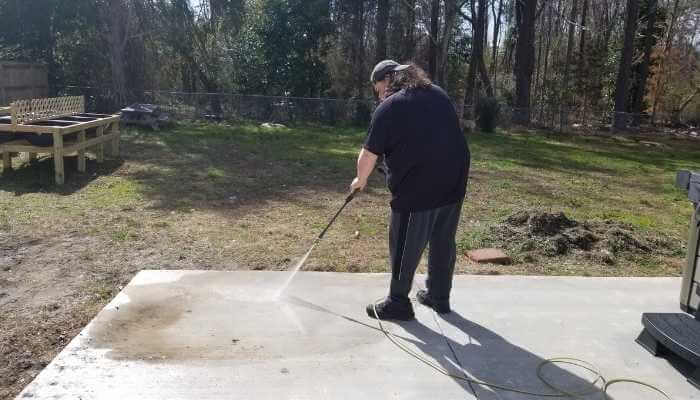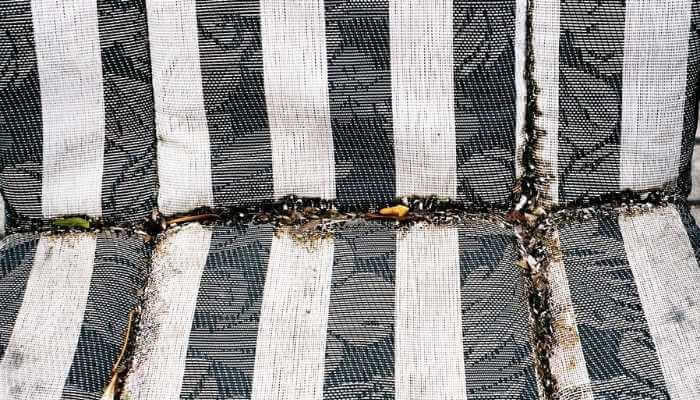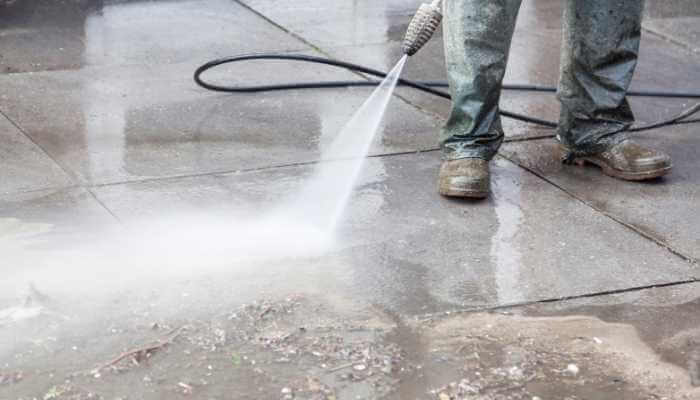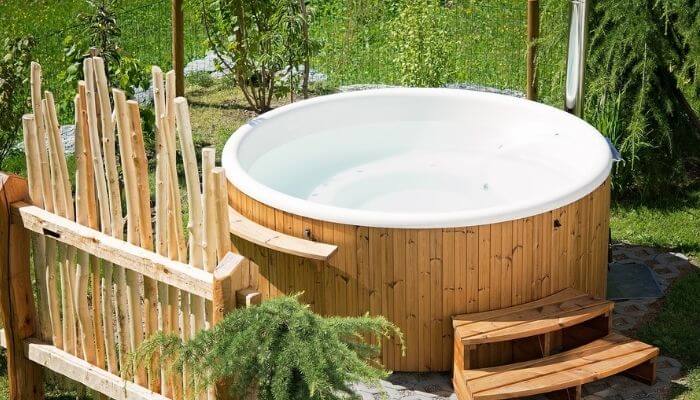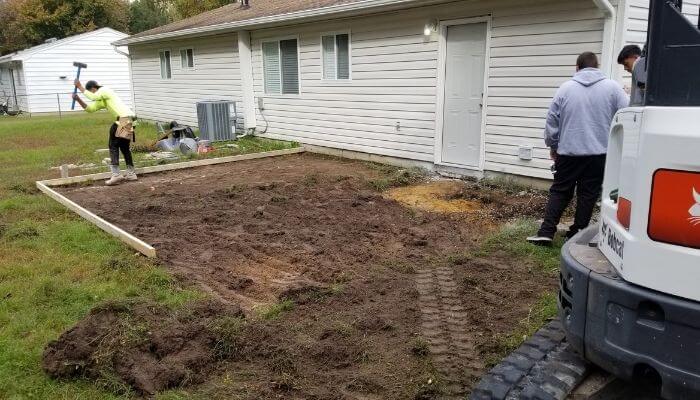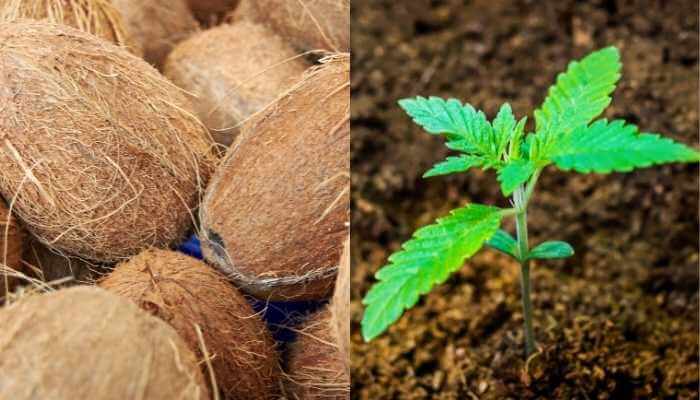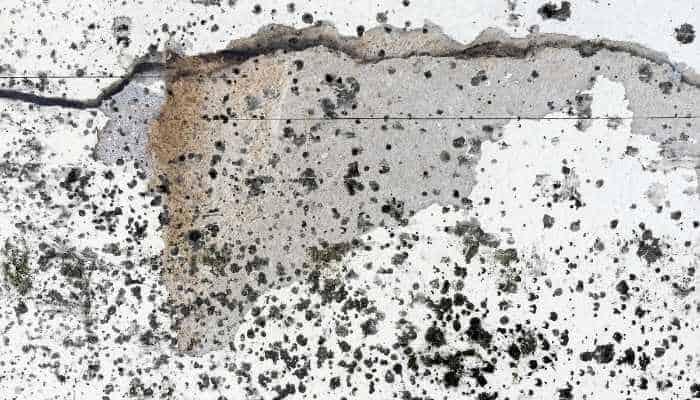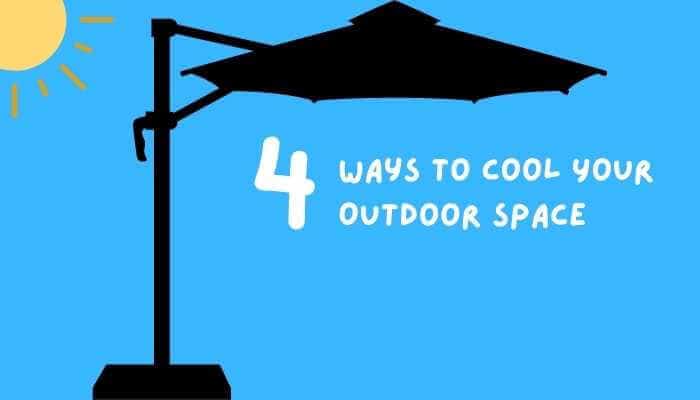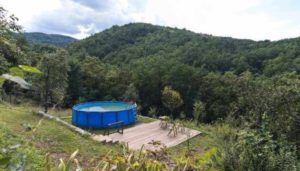
One of my favorite outdoor space foundations is a concrete patio. Concrete can be used in a lot of different ways. Still, it’s inexpensive, durable, and low-maintenance is why most homeowners choose it. However, considering the abuse flooring takes – especially when it’s outside – cleaning concrete isn’t always as simple as you’d imagine the chore to be.
What methods clean concrete patios best? A pressure washer. And if the water jets from the washer aren’t enough, or you don’t have one available, you may need an all-purpose cleaning solution of ¾ cup bleach to 1 gallon of hot water. This can be scrubbed onto the patio and then rinsed off.
Those are the best two methods of cleaning concrete, but what If you have lingering stains? Concrete is known to get dingy after years of use. In humid or damp areas, it’s known to get mildew, mold, and sometimes even grow moss. Not to mention all the hidden gems that are tracked onto it and stains spilled on your concrete.
How often should you clean your concrete patio? Well, that depends upon the conditions. Does it get mold, mildew, or moss a lot? Is it under a bunch of trees that stain it? Is it relatively free of such things and has normal traffic over it?
Definitely clean your concrete entirely once a year (I usually do this in spring, before people start using the patio more often). But otherwise, it’s up to each individual.
Cleaning a Concrete Patio With a Pressure Washer
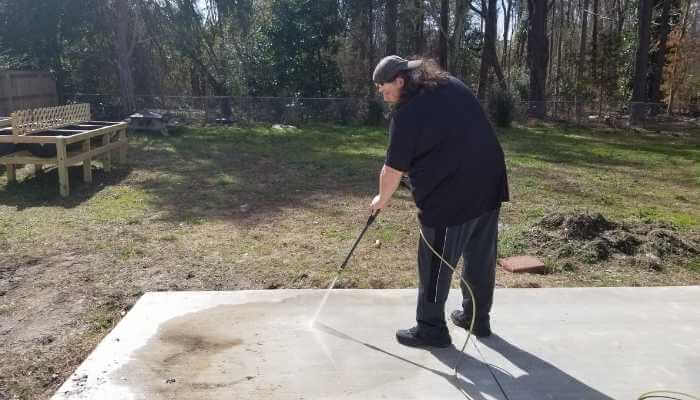
Can you damage concrete by power washing? A pressure washer may be perfect for the job if your concrete is poured. Don’t hold the nozzle too close, be sure to choose the correct spray, and don’t let the power harm your concrete (or anything else for that matter).
Also, many pressure washers allow you to add specific cleaning solutions to be delivered through the machine, making your cleaning easier. For a more in-depth guide to using a pressure washer, I wrote an article giving more information here.
But if your patio is made with concrete pavers or you have a special coating on your concrete, the pressure washer and cleaner can cause problems. Sometimes you want to get the cleaning to happen without a pressure washer. And let’s be fair; not all of us have one or have access to one. How do you clean your concrete if that’s the case?
How to Clean Concrete Patio Without a Pressure Washer
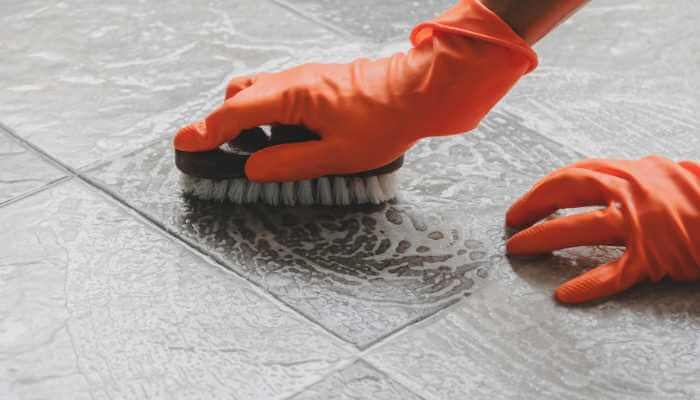
It would be best to clean your concrete at least once a year. Since any furniture on it usually needs a yearly (or more often) cleaning, you could handle all of this at the same time. Also, while moving furniture, consider this a time to look for stains, chips, and cracks that might need repair and cleaning.
Now comes the easy part – getting rid of the dirt and debris. A broom goes a long way, but a leaf blower is so much more fun. You don’t want to do this if the concrete is in an enclosed space and there is a mold or mildew issue.
If there are cracks and possibly weeds along the sides or in gaps that don’t belong, this is the time to get rid of those.
This is also the time to spot-treat stains. The recommendation is to use dishwashing detergent or laundry detergent. Pour the liquid directly on the stains and scrub that spot with a stiff brush. Use nylon or reed, as metal can cause damage to concrete. Rinse it and repeat as needed.
Now, if your spot treatment includes a liquid, that’s different. I try to handle these probable stains as soon as they happen. However, in the garage, sometimes you wind up with oil pooled that you were completely unaware of until you move a vehicle or begin cleaning. Either way, you can use cat litter or baking soda on the liquid. Let it sit for a few minutes to absorb the liquid, and then you can remove it.
Spot checks are essential when working with chemicals. As with any cleaning situation, you must always check a spot hidden from view. You don’t want to worsen a patio by using a product that’s too strong or leaves a stain.
Remove all patio furniture, appliances, decorations, and potted plants. If you need to keep those on the floor (i.e., the concrete is in a room like a garage or a basement), put all items on one side. Clean the empty side. Then, once that side is clean and dry, shift everything back to the clean side and work on the dirty side.
When it comes to plants in the area that you don’t want to kill, move them, cover the ones you can with a tarp, and any you can’t move, be sure to water thoroughly before you clean. This way, the roots soak up the water and not as many chemicals.
Will Bleach Clean a Concrete Patio?
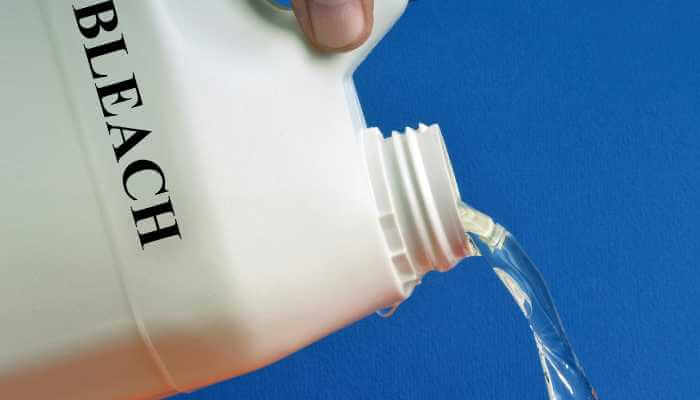
Tough stains might need several treatments of detergents or a specialized cleaner. The most common solution for generalized staining of concrete is:
- ¾ cup bleach
- 1 gallon of hot water
It’s best to leave the mixture on the concrete for a few minutes. Most people have told me 20 minutes should do the trick. Then, you can brush it with a stiff brush (not metal) before either mopping it up with clean water (if your concrete is smooth) or spraying it off with a hose.
You may not need the power – the recipe for the above solution is actually made with regular Clorox® or bleach. But, so that you know, a Clorox® ProResults® (on Amazon) is made specifically for outdoor stains.
Which Bleach Should I Use?
This depends on the level of sanitation you want to achieve. You see, the active disinfectant ingredient, sodium hypochlorite, is effective against bacteria, viruses, and fungi but only in concentrations above 5%.
| Product | % of sodium hypochlorite concentration |
|---|---|
| Clorox® Industrial Bleach | 12% – 15% |
| Clorox®Splash-Less | 1% – 5% variable |
| Clorox® ProResults Outdoor Bleach | 7.5% |
| Clorox® Standard Bleach | 5% – 6.5% variable |
| Clorox® Performance Bleach2 | 7.55% |
| Standard Household Bleach | 5.25% – 6.15% variable |
Bleach won’t harm concrete, and it’s pretty effective. The Clorox® ProResults Outdoor Bleach version is tough enough to be effective and also has an additive that is supposed to help protect metal like outdoor furniture. But please always wear gloves when handling these chemicals.
If you don’t want to use bleach, other solutions are available. I’ll get into those below.
What if I Have Mold on the Concrete Patio?
Use a hose or pressure washer to remove water, mold, or mildew stains from concrete patios and driveways. If stains persist, use the same bleach mixture listed above and handle it. You may have to repeat the cleaning to get all of the stains.
Should you not want to use bleach, a mixture of soft soaps (like Borax) and hot water might be your preferred cleaning agent. Mix the soap flakes in hot water and spread it over the affected areas. Scrub it with a hard-bristled brush that’s not metal. Let the mixture sit, then rinse it off after about 30 minutes.
What if the Mold and Mildew are in an Enclosed Space but on Concrete?
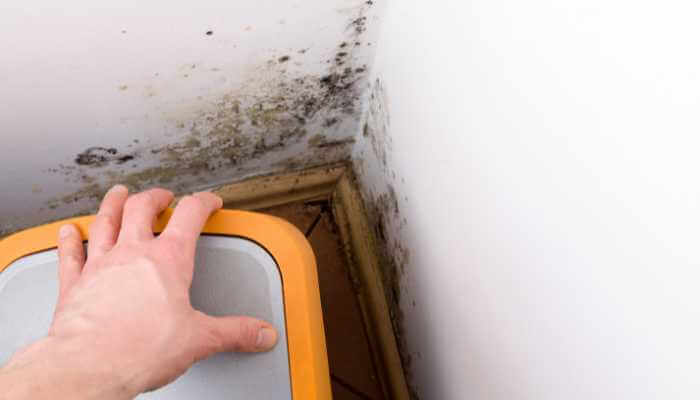
We’re focused on outdoor spaces here, but I wanted to clarify this. I didn’t want anyone to see the basic treatment for mold and mildew on concrete and think those instructions apply to every scenario. Cleaning molded indoor or enclosed concrete is very different from outdoor.
If you have this problem, do not sweep the area! Sweeping can spread mold spores around the basement or garage, causing a bigger problem. Open any windows and allow fresh air to circulate while cleaning.
Spray the problem area with a solution of mold-killing detergent and water or bleach and water (if you aren’t worried about discoloration). Only once the concrete flooring is entirely saturated can you scrub the area with a brush. Rinse the floor with a clean wet mop. Once the area is completely dry, examine it to decide whether to repeat the process.
How Do I Clean Rust Stains from a Concrete Patio?
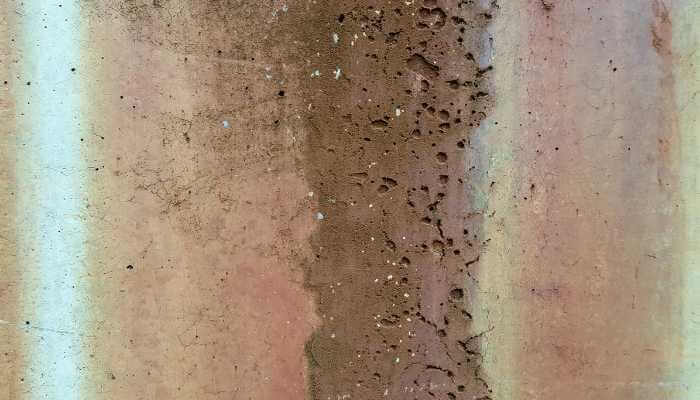
There is one natural cleaning combination that can usually take out rust stains on a concrete floor, no matter how old they are:
- 1 part white vinegar
- 1 part lemon juice
- 1 part elbow grease
You pour the white vinegar or lemon juice directly onto the stain. If you want to use both vinegar and lemon juice, make it a 1:1 ratio. Let that sit for at least 20 minutes, so it can penetrate the concrete. Then, you scrub the area with a stiff-bristled brush (not metal).
A lot of people swear by this mixture:
- 1 part baking soda
- 1 part Borax
- A spray bottle with clean water
This method will mix the soft detergent and baking soda with just enough water to form a paste. That paste must be spread over the rust stain and left for one hour. You should spray the paste with water every few minutes to keep it moist. After the hour, add water to the paste and use a brush to scrub the concrete.
Rinse the area with clean hot water, let it dry, and if needed, repeat. If the stain persists, you can move on to a more potent chemical, like a concrete rust cleaner.
Here are some of the cleaning products I recommend to help clean rust stains from your concrete.
If all else fails, look into chemical cleaners that contain Muriatic acid and Trisodium Phosphate (TSP). Just keep in mind these chemicals are very caustic, and safety measures should be taken when you work with them. I’ll review these at the end of the article because they should only be used if nothing else worked well enough.
How to Clean Bbq Grease Off Concrete
If you’ve just got a small grease spill – Dawn dishwashing detergent can be your friend. However, some grease stains are made of sterner stuff.
As crazy as it may sound, soda can be used to remove grease stains of all kinds.
How does it work? Carbonic acid (carbonated water), phosphoric acid, and citric acid work together to eliminate grease from concrete. Just let it sit on the stain for about 30 minutes, scrub it, as I’ve mentioned before, with a stiff-bristled brush that’s not metal (nylon is safe), and then rinse it.
How Can I Remove Oil Stains from Concrete?
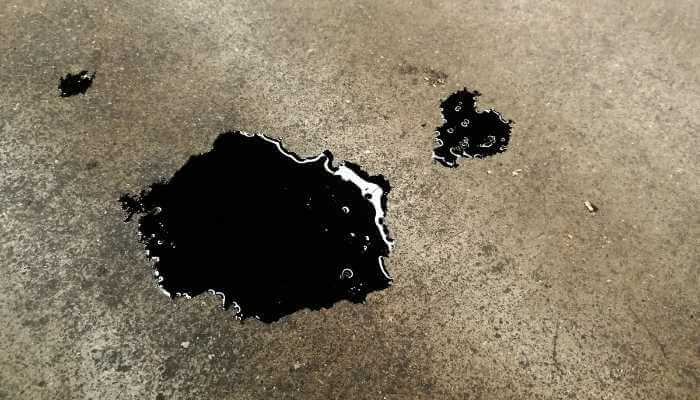
Oil is a lot like grease. And sometimes, it’s pooled on the concrete before we realize it. In that case, use the same method mentioned above in the spot-cleaning. You can add mineral spirits or paint thinner for more substantial cleaning power or let the absorptive material do what it can.
If you use mineral spirits, saturate the stain with the liquid and then cover the stain with something absorbent like cornstarch, baking soda, cornmeal, or cat litter. Let this sit overnight, and then sweep it all up. Use a warm, wet towel to wipe the area and let it air dry. This method is also helpful for oil stains.
If a stain remains, it’s time for round two. Use more baking soda (if you don’t have baking soda on hand, you can use powdered laundry detergent), add warm water, and scrub the stain with a nylon brush. Rinse it with warm, clean water. Let it air dry.
If you still have an oil stain or the stain has seeped in deeper than you thought, try Dawn Dish Soap. Apply it over the entire stain and let it sit for ten minutes before scrubbing it. Normally, this will separate oil from the concrete. Then you just rinse and repeat until it’s gone.
The last resort would be a degreaser. However, keep in mind that degreasers are made from alkaline soap, which cleans up grease and oil but doesn’t necessarily work on stains that have been around for a long time. So, you still may have a stain. Here are some degreasers I would strongly suggest getting for those tough oil stains.
What If My Concrete Patio Is Green?
If your patio is green, you could have a problem with mildew, mold, algae, or moss. This is especially common in humid climates. A specific kind of green mold grows outdoors in these climates. If you want to get rid of it, try and schedule the cleaning during the day, when the sun can dry the area quickly.
It’s best to spray or brush off as much of it as possible without a cleaner. Then, you can treat it with the guidelines I’ve listed above.
Though the ¾ cup bleach to 1 gallon of water mixture that’s used most often tends to work best, you might want to go a more natural route:
- ½ cup white vinegar
- ½ cup soft soap (Borax)
- 1 cup warm water
You can put this mixture into a spray bottle or leave it in a container. Use a sponge to apply it to your green stains. But first, you need to spray off the offending area with water. Best to use a spray nozzle to get rid of any build-up. Make sure to leave the place very wet. Then, you apply your solution.
Let that soak in for at least 15 minutes, maybe half an hour. Then, scrub it with a hard-bristled brush (not metal). If you do this in small manageable areas of your concrete, you will know when to add more cleaning solutions. Once satisfied, spray the entire area off in a good rinse.
What Are These Black Spots?
That depends. There could be multiple reasons that you’re getting black spots on your concrete. I go into much greater detail about cleaning black spots depending on the type in another article. For now, let’s just quickly touch on each.
Did you use a calcium chloride de-icer on your concrete? Because if you did, it might have left black spots or other discoloration behind. It’s important to wash de-icing salts off after you use them, as soon as it’s safe and warm enough that the rinse water won’t freeze.
Water can also cause dark spots – especially if you have a leaky faucet or a gutter system that opens onto concrete. That could be mold or mildew growing where those things love dampness and shade. It could also be mineral deposits caught in the porous surface of the concrete. You can use an ammonia and water mixture to handle this or mineral spirits.
Or, it could be something called trowel-burn. This is especially true when a non-professional pours their own concrete and tries too hard to smooth the surface. This can overwork the concrete and pull water from deeper to the surface, leaving stains.
There’s not a lot you can do about this kind of discoloration.
You must go through the rigorous process of acid-washing your slab or covering the “oopsy” with a stain or colored sealant. Maybe even paint the top with a cement overlay to cover the blemishes.
Then, you’ve got discoloration left from tree detritus. Black spots are very common when you have specific nuts left on your patio for long periods. Black walnuts are notorious for leaving stains.
Black stains tend to be full chemical responses within your concrete. So it may take full chemical reactions to clean them up. If the standard bleach and water won’t work, here’s what you may need:
- Granular Chlorine (yes the kind used in pools)
- ⅔ cup of soft soap flakes aka Borax or FOCA
- 4 tablespoons Dawn Liquid Dishwashing Detergent
- A mop bucket of hot water
- A spray bottle of water
The first thing to do is dampen the stained area with water (not too much). Then, sprinkle the granular chlorine on the stain. Using a spray bottle of water, mist the water over the chlorine. Let the solution sit on the stain and do its job. Usually, this takes 5 minutes. Be safe when you use chlorine. It’s caustic.
In the meantime, you need to fill a mop bucket with hot water, the Dawn dish detergent, and ⅔ cup of soft soap flakes. Once the five minutes are up, use the mixture in the mop bucket to scrub the stains vigorously using a nylon brush. Rinse and repeat until the stain is gone or you give up.
Another method you could try is using a potent mixture of chlorine bleach to coax the stain to leave. You’ll need 1 part bleach to 2 parts hot water in a bucket. Pour that mixture over the concrete and let it sit for 30 minutes. Then, rinse the area with a high-pressure hose or a pressure washer.
You may have to repeat this until the stain is broken up and flushed away.
For a deeper dive into this topic, I wrote a more comprehensive article about the different black spots on concrete.
How Do You Get Rid of Urine Stains and Smells?
I wrote a more in-depth article about this problematic issue. Why? Because I’ve dealt with it enough myself. Pretty much wherever we live, we’ve had animals. And with animals comes – TADA! – urine and feces. So, it’s best to be prepared.
If you know you have a problematic pet, you may want to get some deterrents up front. You can find chemicals, solutions, and plants that may help keep your pets away from the patio. My dog hates Citronella, for instance. So, I plan on making some purchases to go where I do not want her to be.
A vinegar and water solution doesn’t just eliminate odors from where a dog has already urinated – it’s a natural deterrent. I’m not overly fond of the smell, though. If it’s going in your outdoor living space, consider that before spending a lot of money on these things.
If you’ve already got a problem – a urine stain that also carries with it a bad smell – here are some possible solutions:
- 2 cups hydrogen peroxide 2 parts vinegar
- 2 teaspoons of baking soda OR 1 part baking soda
- a little Dawn dish soap 2 parts hot water
Always use the same cleaning method of spreading the solutions, letting them soak, brushing the concrete with a non-metal brush, and rinsing it. You may want to use the solutions on every part of your concrete. Why? Because whether you use chemicals or not, the cleaned concrete might be a different color than the rest. Plus, if you use vinegar, it’s also a deterrent, not just a cleaner.
Once the urine stain is cleaned, there’s a second step – using an enzymatic cleaner. This uses ‘good’ bacteria, which produce enzymes to break down the uric acid crystals left by the first cleaning. The bacteria digest the crystals and break them into carbon dioxide and water.
Always use these cleaners by the instructions given. Remember that many of them need to be left in place overnight so that the enzymes can soak in and work. Keep pets and children away from it. If you have to, cover the concrete being treated with a tarp.
How Can I Clean a Concrete Patio Without Killing Grass?
Most chemicals and solutions are toxic to plants. That’s why it’s so essential that you water your plants that are around the concrete that you plan to clean. You want the plants to soak up the water and not the chemicals.
You can cover them with a tarp or plastic trash bags so they get as little exposure to chemicals as possible. There is also a plethora of “environmentally friendly” cleaning solutions for sale.
Clorox® ProResults Outdoor Bleach claims it does not harm grass when used as directed. But to prevent any chemical burns to plants, rinse those plants if they come into contact with the bleach. That’s my opinion.
If you want to use a homemade cleanser that will not be toxic to your grass or plants – water & vinegar or water & baking soda are the clear choices. Your solution should be equal parts water & vinegar or water & baking soda.
Put these solutions in a spray bottle, add a tiny bit of non-toxic liquid dish soap (I use Dawn, which people use for cleaning up animals when they end up in oil sludge), and then shake it up, spray the concrete, and let it sit for about half an hour. Then, scrub the stains with a nylon brush and rinse the filth away.
Also, if the stains aren’t that tough, use hot water and soft soap flakes (or Dawn dish detergent) mixed together and poured over your concrete. Let it sit, scrub it with a hard-bristled brush (not metal), then rinse it. These types of cleaners should not harm your grass.
If Everything Else Fails
Muriatic acid and Trisodium Phosphate (TSP) are your last resort before calling in the professionals. And to be honest, professionals may also use these chemicals. These are really caustic and can cause a lot of damage to your skin, eyes, and lungs if you don’t take proper precautions. Hence – they are the last resort.
TSP has been banned in some states, so check your local laws before purchasing any. Look for an environmentally-safe TSP alternative that can provide the same cleaning action without harmful effects.
The standard way to use TSP for concrete cleaning is:
- 1cup TSP
- 1-gallon hot water
Pour that mixture over the concrete and let it sit for 15-20 minutes. Scrub the area, then rinse the area thoroughly with clean water. As always, if you decide to use chemicals instead of homemade cleaners, follow the manufacturer’s guidelines on safety and usage.
In Conclusion
Remember that you can avoid tons of hard work cleaning your concrete by sealing it. Sealing your concrete will protect it against damage and deterioration from water absorption and surface abrasion. Besides protecting it from stains, sealants make your concrete more resistant to cracking, pitting, mold, mildew, and salt damage.
Penetrating sealers (or impregnating sealers) can prevent damage and stains by holding liquids on top of the surface of your usually porous concrete. They make concrete resistant to absorbing organic materials like dirt, water, oil, and salt while allowing the surface to breathe.
Not only do sealants help protect your investment in your outdoor space, but they can also enhance the look of your concrete. Some even add color.
It’s your decision. The methods I wrote about for cleaning your concrete are not simple. None of them are guaranteed to remove 100% of the stains on your concrete—just something to keep in mind. Good luck!
